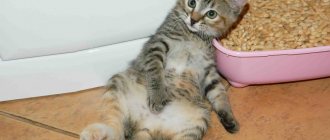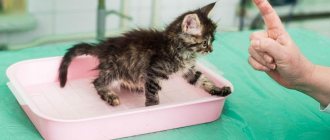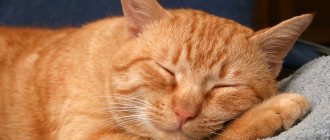By taking a kitten home, a person takes responsibility for its health. Therefore, any symptoms of the disease should alert him. For example, you should contact a veterinarian if you begin to notice that your cat is not peeing a lot. Such a deviation from the norm may be the first signal of the development of the disease.
Some people think that their pet goes to the toilet too often, while others think that it goes to the toilet too rarely. And this is really a serious cause for concern, because in both cases such behavior can be a consequence of illness. So, how many times should a cat go to the toilet, and when should you start to worry?
What affects going to the toilet?
Before you start getting acquainted with the “norms,” it’s worth talking a little about what affects the number and frequency of visits to the litter box.
Firstly, this is, of course, age. Kittens, adults and older cats go to the toilet with different frequencies. Secondly, the regime and diet. Everything is simple here, for example, the more often your pet drinks, the more often he will visit the litter box.
In addition, each cat, like a person, has its own habits and rhythm of life, so it is not surprising that one pet has to be cleaned 2-3 times a day, while another can be found in the tray only once a day. That is, it is necessary to make allowances for the characteristics of a particular animal and its body.
Re-education of kittens
Raising a new pet should begin from a very young age. If you do not teach a kitten to go to the litter box as a child, then retraining an adult will be extremely problematic, and professional help may be required.
During litter training, you need to treat the kitten kindly
As soon as a kitten appears in the house and goes to the toilet on the floor, it cannot be scolded. It is necessary to thoroughly wipe the area of the puddle so that no traces of the unpleasant specific odor remain. Here you need to install the first tray, which will not be difficult to climb into.
The next time the animal starts to worry and look for a secluded corner to relieve itself. We need to help him. Carefully pick him up and take him to the place where the tray is located. Pet and calm the animal so that it does not feel afraid. If you use the right re-education methods at an early age, there will be no toilet problems in the future.
Helpful advice! In the first few days of training, it is not recommended to wash the tray; it is better to tolerate unpleasant odors. The kitten will be able to find its toilet faster.
If a small pet went to the litter box once and went to poop near the door or found another secluded corner, then he needs to buy a second cat litter box. It often happens with cats that they cannot do both in one place. You shouldn’t scold them for this, just put a new tray where your pet goes for other things.
It is very important to encourage a little kitten when he goes to his toilet instead of on the floor. You need to play with the animal, pet it and simply verbally thank it - they feel a kind tone and understand what is wanted from them. Training your pet to go to the toilet is not difficult if you do it from childhood
In adulthood, retraining will take a lot of time and effort from the owner. Retraining methods are generally similar, but it is worth remembering that each cat requires an individual approach. You can’t expose cats to stress, beat them or yell at them for misdeeds. Love, affection and patience will help you overcome all difficulties.
Training your pet to go to the toilet is not difficult if you do it from childhood. In adulthood, retraining will take a lot of time and effort from the owner. Retraining methods are generally similar, but it is worth remembering that each cat requires an individual approach. You can’t expose cats to stress, beat them or yell at them for misdeeds. Love, affection and patience will help you overcome all difficulties.
Why does a cat pee a little?
A cat should pee, if it is already a year old, about 2 times a day. If urination does not occur for several days or a very small amount of urine is found in the tray, this indicates a malfunction in the body.
This phenomenon can be caused by the following factors:
- Kidney diseases of congenital or acquired type.
- Urolithiasis (the most common reason why a cat doesn’t pee a lot).
- Inflammatory processes in the urethra or bladder. They can be caused by hypothermia or infection.
- Weakening of the bladder walls (atony). The reason for this may be an injury, surgery, illness, or age-related changes in the cat’s body.
- Anuria. This condition is characterized by the absence of urine and poses a threat to the animal's life.
- Spinal cord damage due to spinal injuries.
- Benign or malignant tumors.
Only a veterinarian can determine the reason why a cat pees little.
Safe deviations from the norm
Stress can disrupt a cat's routine.
The animal may occasionally experience deviations from the norm when urinating. The pet can walk small once every 1-2 days. The reason may be:
- stress;
- climate change;
- change of feed;
- carrying out sterilization or castration.
As for sterilization and castration, it takes up to 2-3 days for cats to restore function. Neutered cats take longer days because they undergo deep surgery. The first days after the procedure, they go to the toilet through a catheter.
Pathological deviations from the norm
The genitourinary system of a cat.
If your cat has not gone to the toilet for more than 2 days
, or urination is difficult, comes in scanty doses, then the animal should be examined.
Inflammatory processes in the body can be accompanied by the following symptoms:
- lack of urination;
- difficulty urinating with scanty discharge;
- it is painful for the animal to go to the toilet, which is expressed by frequent meowing;
- the presence of various impurities in the urine (blood, mucus, sand);
- apathy, bad mood;
- lack of appetite;
- elevated temperature;
- general poor health (hot tips of the ears, pale and unhealthy-looking gums);
- swelling in the abdominal area.
Video about acute urinary retention in a cat
Urolithiasis
Symptoms of urolithiasis.
They often occur due to hypothermia, as well as poor nutrition, cheap feed, and poor animal hygiene. They affect cats more, both regular and neutered, due to the specific structure of the genitourinary system.
If the animal has no desire to go to the toilet for more than two days, the pet does not feel well, its stomach is swollen, or there are any impurities in the urine, then contact your veterinarian immediately
. If the disease progresses, surgery may be required.
Prevention of urolithiasis and diseases associated with the kidneys and genitourinary system
Don't forget to change the water in your cat's bowl.
To protect your pet from urinary problems, owners should:
- feed your cat or cat in a balanced manner (2-3 times a day);
- give clean water;
- include in the diet not only dry food, but also canned food, boiled chicken, meat, fish (no more than once a week), dairy products, cereals;
- wash the tray thoroughly;
- keep the house clean;
- do not allow the animal to become hypothermic;
- notice changes in your pet’s behavior in time and contact a veterinarian.
The health of cats depends primarily on their diet. As a rule, kidney and bladder diseases often occur in overweight cats.
In addition, food also influences the occurrence of pathologies. It is not recommended to give dry food frequently. Veterinarians advise. If your pet already suffers from urolithiasis, then it is necessary to include appropriate food in its diet.
Frequent urination in cats is called pollakiuria in veterinary medicine and can occur for a variety of reasons. This is a rather unpleasant condition, in which the main thing is to contact a veterinarian at the first sign in order to treat your pet as effectively as possible. Positive dynamics can only be achieved with an integrated approach, but if this condition is prolonged, then in the future there may be a lack of urination, which can lead to the death of the cat. In our article we will tell you why and under what diagnoses this condition can occur in cats, and how to treat it.
How many times do kittens go to the toilet?
Very young kittens (up to 3-4 weeks) feed exclusively on mother's milk. Their digestive system is not yet very developed, so there is no need to talk about any regularity.
Starting from the age of one month, kittens learn to drink milk from a saucer and gradually become interested in other foods, including solids. In addition, at this age their digestion is improving, so, although irregularly, they need to go to the toilet. On average, up to three months, a kitten can go to the toilet from 1 to 3 times a day, both “big” and “small”
Starting from 3 months of age, the process of going to the toilet should gradually normalize and become regular. The acceptable maximum can be considered 3 “piles” and 6 “puddles”. The high activity of the kitten has a big influence here, because at this age he constantly plays and runs around a lot, which is why he drinks a lot.
Normal frequency of urination in cats
Those who have just bought themselves a mustachioed and striped friend often ask how many times a day a cat should pee. These animals initially existed with a lack of moisture, so they drink little, and their urine is extremely concentrated. Actually, this is what causes the specific and well-recognized smell of cat urine.
There is no need to be alarmed if your cat does not pee several times a day; it may happen once or twice a day. In principle, this is within normal limits, especially if the animal receives wet food and drinks very rarely and little.
This primarily applies to small kittens. Their urine is separated in minute quantities due to the fact that they feed on liquid food - mother's milk, which is almost completely absorbed by the kitten.
In addition, a caring cat constantly licks her kittens, so it may seem as if they are not urinating at all. Only after children begin to feed themselves can owners notice that they go to the toilet infrequently. This is also the norm for animals up to one and a half to two months.
It’s another matter if owners notice urinary problems in older animals. Normally, they can urinate 1–2 times a day. Frequent urination may indicate the presence of chronic renal failure (CRF), and too infrequent urination may indicate various health problems, including urolithiasis, which is very dangerous for cats.
When to contact a veterinarian
The topic of infrequent urination in cats comes up quite often. However, sometimes owners simply cannot keep track of how often their pet pees. Most often, difficulties in this matter arise if the cat goes outside.
If you rarely let your cat drink, she may also have trouble urinating. She will not urinate much due to dehydration. Therefore, first of all, if you notice that your cat hardly pees, you need to make sure that there is always water available to her. If after this the symptom disappears, then there is no need to go to the veterinarian.
Contacting him becomes inevitable if such symptoms are noted.:
- During urination, the cat screams or meows loudly.
- The cat pees too little or too much.
- The consistency, color or odor of the secreted fluid has changed.
- The cat became lethargic and sleepy.
- The animal refuses water or suffers from constant thirst.
- The pet's temperature rises.
These signs can be observed if the cat cannot go to the toilet for more than a day.
How often does an adult cat pee?
Normally, an adult pet can pee from 2 to 6 times a day. If he is lazy to such an extent that he won’t even get up to drink once again, then it’s understandable that the cat pees once a day. More active pets, with whom their owners often play and walk, tend to drink a lot and often, and therefore pee.
The cat's nutrition plays a big role. If you feed him dry food, he should have regular access to fresh, preferably filtered, water. Many owners wonder why their cat pees often. Most likely, the fact is that he overeats dry food and drinks a lot, which provokes frequent urges. However, you need to make sure that blood does not appear in the urine.
It has already been mentioned that cats are more prone to developing urological diseases than cats. In their narrow channels that remove urine, a large number of salt crystals accumulate, from which stones are formed. Some experts say that animals should drink 3 times more water than they eat dry food. So roughly calculate how much fluid your pet needs to receive. If he drinks very little, try giving him extra water from a syringe without a needle. Close attention should be paid to neutered cats, as they are more susceptible to urological diseases.
What to do if the cat doesn't pee
When visiting a veterinarian, your cat needs an ultrasound examination of its kidneys and a urine test. Based on the studies obtained, a diagnosis will be made.
In this case, the veterinarian will choose one of the following treatment regimens:
- For bacterial diseases, antibiotics will be prescribed.
- If the reason for rare urination is not bacteria, then the cat will be prescribed medications against viruses and inflammation. Painkillers, diuretics and antihistamines will help relieve symptoms. In some cases, there is a need to prescribe steroid hormones.
- If there is a threat to the animal's life, the veterinarian resorts to surgery.
Not knowing what to do with a suffering pet when it doesn't pee, people often take any action to treat it themselves, thereby wasting valuable time. Therefore, if an adult animal or kitten urinates little and there are accompanying symptoms, you should immediately consult a veterinarian. In this case, you cannot self-medicate. This may result in various complications or death.
Sources:
https://koshkamurka.ru/6067-koshka-malo-pisaet.html
https://24pet.ru/articles/how-many-times-a-day-cat-must-go-to-the-toilet/











